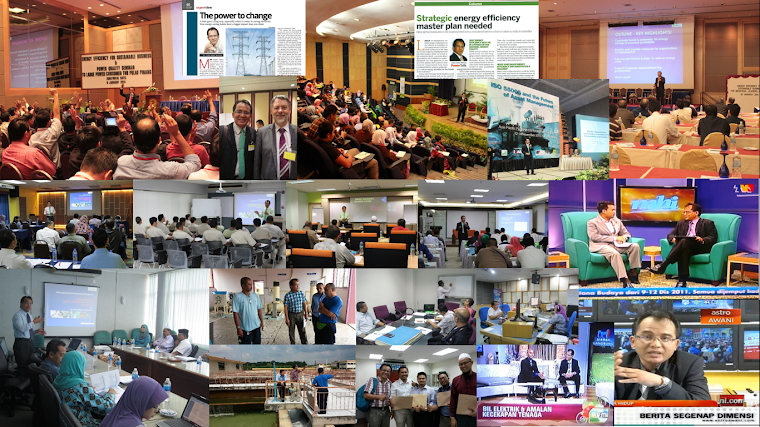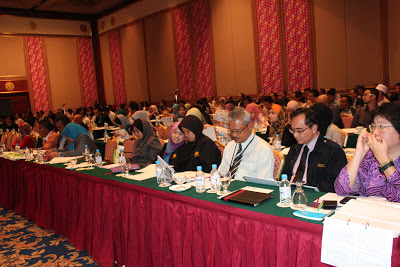 |
| A night before the first session...and now we are into the fifth session |
Workshop Sessions for 2013
Dates:
- 3rd Session: 23 February 2013 (successfully conducted)
- 4th Session:27 April 2013(successfully conducted)
- 5th Session:13 July 2013 (registration is now open...)
Venue:
Shah's Village Hotel, Petaling Jaya
Fee:
RM600/participant
RM500/partcipant( for a company with at least 2 participants in the same session)
Contact details to register
MAESCO
Tel:
+603-78730784
+603-78730786
Fax:
+603-78730769
E-mail: training@maesco.org.my or+603-78730784
+603-78730786
Fax:
+603-78730769
log on to www.maesco.org.my for the registration form.
INTRODUCTION
I started this program in the end of 2012 with the ultimate goal to assist the regulator to increase the number of REEMs in the current market which is still insufficient to ensure compliance towards the Efficient Management of Electrical Energy Regulations 2008. It was announced by the regulator recently that as at December 2012, only 207 REEMs registered with them and there are about 1,500 installations have to comply to the regulations.
Together with MAESCO, we had two sessions in September and October 2012. Now I intend to expand this program to be conducted at more platforms to enable it to reach more people who may be benefit from it.
Actually,I believe there are many people out there with experiences and qualified to apply but still unsure on how much they have met the requirements and how exactly to put all that in writing in the application form. Some even have the idea of it would be easy to get registered, the interview and examination would be very tough to pass and many other perceptions that make them not applying.
It the workshop, me myself with assistance from 1-2 more REEM will share our experiences from the beginning of the application process until the interview session by the panelist.I will also will share my direct experiences in evaluating the applications and as one of the panelists for the interview session. The whole idea of the outline program as indicated below is to guide the candidates in the application process and to build their confidence to submit if they have met the minimum requirements according to the regulations.
Together with MAESCO, we had two sessions in September and October 2012. Now I intend to expand this program to be conducted at more platforms to enable it to reach more people who may be benefit from it.
Actually,I believe there are many people out there with experiences and qualified to apply but still unsure on how much they have met the requirements and how exactly to put all that in writing in the application form. Some even have the idea of it would be easy to get registered, the interview and examination would be very tough to pass and many other perceptions that make them not applying.
It the workshop, me myself with assistance from 1-2 more REEM will share our experiences from the beginning of the application process until the interview session by the panelist.I will also will share my direct experiences in evaluating the applications and as one of the panelists for the interview session. The whole idea of the outline program as indicated below is to guide the candidates in the application process and to build their confidence to submit if they have met the minimum requirements according to the regulations.
TARGET GROUPS:
- Companies affected by the enforcement of Efficient Management of Electrical Energy Regulations 2008 - for those interested to get their internal personnel to get registered
- Training providers who are interested to add new program into their training calenders
- Individuals and consultants who are interested to offer REEM services to existing and new clients
LEARNING
OUTCOMES
By the end of the workshop the
participants would be able to:
•
prepare
a completed application form to become A Registered Electrical Energy Manager
•
prepare
for an interview by Energy Commission
with the comprehensive step-by-step
guidelines and tips by the workshop leader
9.00 a.m
|
Introduction
|
9.15 a.m
|
1. Overview on key provisions
in Efficient Management Of Electrical
Energy Regulations 2008
|
10.15 a.m
|
Morning
Break
|
10.30 a.m
|
2. Evaluation criteria for
application to register as electrical energy manager under Efficient Management Of Electrical
Energy Regulations 2008
|
12.00
|
3. Workshop
|
1.00 p.m
|
Lunch
|
2.00 p.m
|
4. Tips to
prepare for the interview
|
3.00 p.m
|
Tea Break
|
3.15 p.m
|
5.Workshop
Wrap up
session and Conclusion
|
5.00 p.m
|
End of program
|
GENERAL INFORMATION
- Trainers are certified by PMSB
and qualified companies eligible to claim from HRDF
- Materials requirements
- Sample of report(s) For Energy Saving Project by each participant(to be used for the workshop)
- A copy empty application form for REEM registration by each participant – can be downloaded from www.st.gov.my (to be used for the workshop)
- No guarantee to get registered with Energy Commission since the result of the application will depend on the actual performance of the candidate in the interview session by the Energy Commission
- Available for in-house and public
programs
OPTIONS FOR THE PROGRAM
In-house:
- 5-10 participants
- Venue, LCD Projector, Food and Beverages – to be provided by the hosting company
- Workshop notes from the trainer
Public:
- 10-20 participants
- Venue, LCD Projector, Food and Beverages – to be provided by the organizer
- Workshop notes from the trainer
Further inquiries can be forwarded to zainiabdulwahab@yahoo.com or to
contact me at 0192152700
BRIEF
INFORMATION OF THE WORKSHOP LEADER
ZAINI ABDUL
WAHAB
Mr. Zaini Abdul Wahab started his career
as energy efficiency (EE) consultants in
1997 for
local and multinational consulting firms and assigned to secure and
deliver services to industrial and commercial clients.
He joined Energy Commission of
Malaysia in 2004 and then promoted to head the Demand Side Management (DSM)to
regulate, develop and promote EE industry in Malaysia from the head office in
2007. Among his key responsibilities in Energy Commission was preparing the strategic implementation and enforcement plan for the
Efficient Management of Electrical Energy Regulations 2008, technical
evaluation for EE and RE projects for fiscal incentives under MIDA, EE capacity
building programs for industrial and building sectors and standard and labeling for electrical appliances.
He was deeply involved in the preparation of the evaluation criteria for application to become
a registered electrical energy manager(REEM) and was one of the panelists for
the interview sessions for qualified applicants from 2009 until 2010 when he
was the head of the DSM Unit in Energy Commission.
Then Mr. Zaini was appointed by the Ministry of Energy, Green Technology and Water(KeTTHA) as one of the
key experts to prepare and propose strategic energy efficiency initiatives in the National Key Economic Area (NKEA) Lab by PEMANDU under Oil, Gas and Energy
Sector(OGE) for Economic Transformation
Program (ETP) in Jun-July 2010. Then he was assigned to
Head the special Project Unit to implement energy efficiency initiatives under the
Entry Point Project 9(EPP9), OGE, ETP at KeTTHA from
January until August 2011. In the
same time he was extensively involved in the strategic national policy and
legislation development for EE and
conservation with the ministry as the key technical resource person.
Mr. Zaini
became the Director of Energy Efficiency at Sustainable Energy Development Authority
(SEDA) Malaysia to continue leading national EE initiatives under ETP and also as the key resource person in the
drafting of the proposed EE &
Conservation Act by KeTTHA.
Now Mr.
Zaini is the Director of Operation at Connecsys Sdn Bhd, a company specializing
in investments, consultancy and advisory for total energy conservation and
renewable energy projects solutions & implementation.
He is a
registered consultant with Asia Development Bank and an elected committee
member in the Malaysia Association of Energy Service Company(MAESCO). In
capacity building programs, Mr. Zaini is
an expert trainer for MAESCO’s energy management training
courses and in Industrial
Energy Efficiency for Malaysian Manufacturing Sector Program organized
by United Nation Industrial
Development Organization(UNIDO) from
2012.
KEY AREAS OF EXPERTISE
AND EXPERIENCES
- Sustainable Energy Management System development and ISO 50001: Energy Management System(EnMS) requirements for organizations;
- Energy efficiency and conservation regulatory framework and policy development for countries and organizations;
- Planning, development and conducting capacity building programs in energy management & energy efficiency applications and technologies.
- Energy auditing, measurement, monitoring of energy performance and utility cost analysis for industrial and commercial buildings; and
- Technical evaluation of energy conservation projects;
Qualifications:
- Registered Electrical Energy Manager with Energy Commission (PTE-0016/2012)
- Certified Trainer by Human Resource Development Fund(HRDF)
- Bachelor Degree in Mechanical Engineering(Hons),UKM.
 |
| Simulation of interview session with experienced REEMs as panelists |
 |
 |
| Lecture |
 |
| Tips for report writing for submission |
 |
| Practical: Interview session by REEMs |
 |
| First batch |
 |
| Workshop |
 |
| Practical: Answering interview questions |
 |
| second batch |









.JPG)




.JPG)










